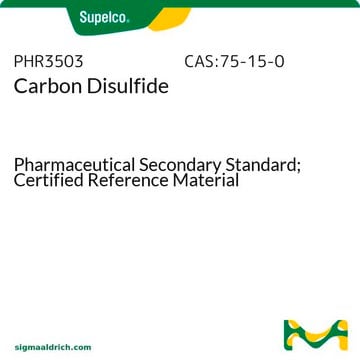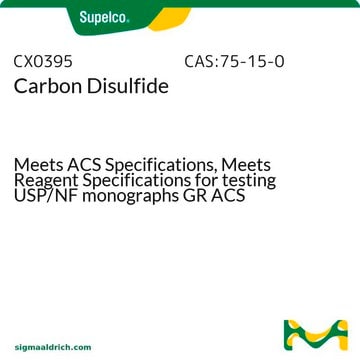342270
Disulfuro de carbono
ReagentPlus®, low benzene, ≥99.9%
About This Item
Productos recomendados
grado
reagent
Nivel de calidad
densidad de vapor
2.67 (vs air)
presión de vapor
5.83 psi
Línea del producto
ReagentPlus®
Ensayo
≥99.9%
Formulario
liquid
temp. de autoignición
212 °F
purificado por
glass distillation
lim. expl.
50 %
dilution
(for general lab use)
impurezas
<0.05% water
<1 ppm Benzene
residuo de evap.
<0.0003%
índice de refracción
n20/D 1.627 (lit.)
bp
46 °C (lit.)
mp
−112-−111 °C (lit.)
densidad
1.266 g/mL at 25 °C (lit.)
cadena SMILES
S=C=S
InChI
1S/CS2/c2-1-3
Clave InChI
QGJOPFRUJISHPQ-UHFFFAOYSA-N
¿Está buscando productos similares? Visita Guía de comparación de productos
Categorías relacionadas
Aplicación
- To synthesize hydroxynaphthyl ketones via Friedel-Crafts acylation and demethylation.
- In the regioselective bromination of binaphthols.
Información legal
Palabra de señalización
Danger
Frases de peligro
Clasificaciones de peligro
Acute Tox. 4 Inhalation - Eye Irrit. 2 - Flam. Liq. 2 - Repr. 2 - Skin Irrit. 2 - STOT RE 1
Órganos de actuación
Peripheral nervous system,Central nervous system,Cardio-vascular system,Eyes
Código de clase de almacenamiento
3 - Flammable liquids
Clase de riesgo para el agua (WGK)
WGK 2
Punto de inflamabilidad (°F)
-22.0 °F - closed cup
Punto de inflamabilidad (°C)
-30 °C - closed cup
Elija entre una de las versiones más recientes:
¿Ya tiene este producto?
Encuentre la documentación para los productos que ha comprado recientemente en la Biblioteca de documentos.
Los clientes también vieron
Active Filters
Nuestro equipo de científicos tiene experiencia en todas las áreas de investigación: Ciencias de la vida, Ciencia de los materiales, Síntesis química, Cromatografía, Analítica y muchas otras.
Póngase en contacto con el Servicio técnico




![Cyanide standard solution traceable to SRM from NIST K₂[Zn(CN)₄] in H₂O 1000 mg/l CN Certipur®](/deepweb/assets/sigmaaldrich/product/images/920/032/af45eec3-100b-4996-8eb3-c3942d441bc9/640/af45eec3-100b-4996-8eb3-c3942d441bc9.jpg)




